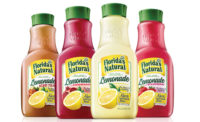![]()
Ingredients and Marketing: Teamwork Results in New Products
By JAMIE POPP
Looking at the
myriad colors, flavors and nutrients beverages offer, it makes one
wonder how new beverages formulations could exist with so many
already available. It is true that beverage companies are notorious
for coming up with wild ideas, spurred by consumers and made
reality by ingredient companies. However, sometimes sales and
marketing come up short in their creative endeavors, and that is
when ingredient companies step in with their own ideas. The
relationship between sales, marketing, R&D and an ingredient
company can be structured in many ways.
“It’s hard to generalize.
Depending on each company’s retail size, not all of them have
R&D groups,” says Walt Postelwait, vice president and
general manager at Blue Pacific Flavors, City of Industry, Calif.
“In that case, the company may use ingredient suppliers to do
all of the development. It depends on the size of the company
and its development strategies and
philosophies. Some companies bring an ingredient company in to the
product ideation phase, which is very beneficial because we work in
many different finished application areas and this broad knowledge
of food and beverage development may be useful in developing a new
product concept.”
But it’s not only the size and
philosophy of the company that determines how R&D, sales and
marketing split up the tasks of developing a new product with an
ingredient company.
“Ingredient company involvement can
happen a couple ways,” says Greg Andon, business development
manager at TIC Gums, Belcamp, Md. “There are times when a
manufacturer will find itself short of resources and in need of an
answer, and it downloads the complete development to an ingredient
manufacturer. At other times, the customer has done some basic
development and they call on us to help them refine it.”
In addition to
generating ideas with sales and marketing professionals, ingredient
companies are also dependent on them for establishing a budget. The
importance of understanding the sales and marketing goal of a
product is paramount when discussing budgets — and sticking
to them. However, it’s not only a concept that determines the
budget. Sometimes an ingredient is used as a marketing tool, and
can affect the budget.
“In the case of replacing an ingredient
such as high fructose corn syrup, it’s the marketing team
that can determine the need,” Andon says. “When possible, we always try to determine a
manufacturer’s budget for stabilizers and their ultimate goal
for the project. Is it a functional improvement at the same cost,
or a similar product with a different cost?”
The finished product’s price point also
dictates how an ingredient company may initiate a beverage
formulating solution.
“Before we work on a project, we want to
know on a case-good basis, or finished product basis, what cost
range the product needs to be in,” Postelwait adds.
“Then we know what ingredients we can work with as far as
beverage formulation and flavor are concerned.”
As the beverage industry becomes increasingly
competitive, ingredient companies also take the initiative to come
up with new products that hit on trends in the marketplace. For
example, Blue Pacific developed a solution to allow juice and milk
or juice and soy to be combined in a stable beverage in a
shelf-stable package, responding to the focus on wellness in the
industry. According to Postelwait, the product “doesn’t
need to be retorted; it needs to be hot-filled and can be put into
PET or glass.”
Working with a number of customers with the
same goal, TIC discovered it could replace HFCS with gum Arabic and
developed TIC Pretested Pre-Hydrated LC Corn Syrup Replacer as a
replacement for high fructose corn syrup in nutritional bars,
according to Andon.
Packaging also plays a role in ingredient
innovation. Blue Pacific has teamed with Sonoco, a retortable
plastic bottle manufacturer, to handle new self-heating cans that
require new beverage formulations.
The role an ingredient company plays in the
R&D process can take a reactive or a proactive approach,
depending on the manufacturing company’s product development
and philosophical goals. Whether ideas are generated by ingredient
manufacturers and introduced to producers or vice versa, the
relationship results in a two-way street for new product concepts. BI




